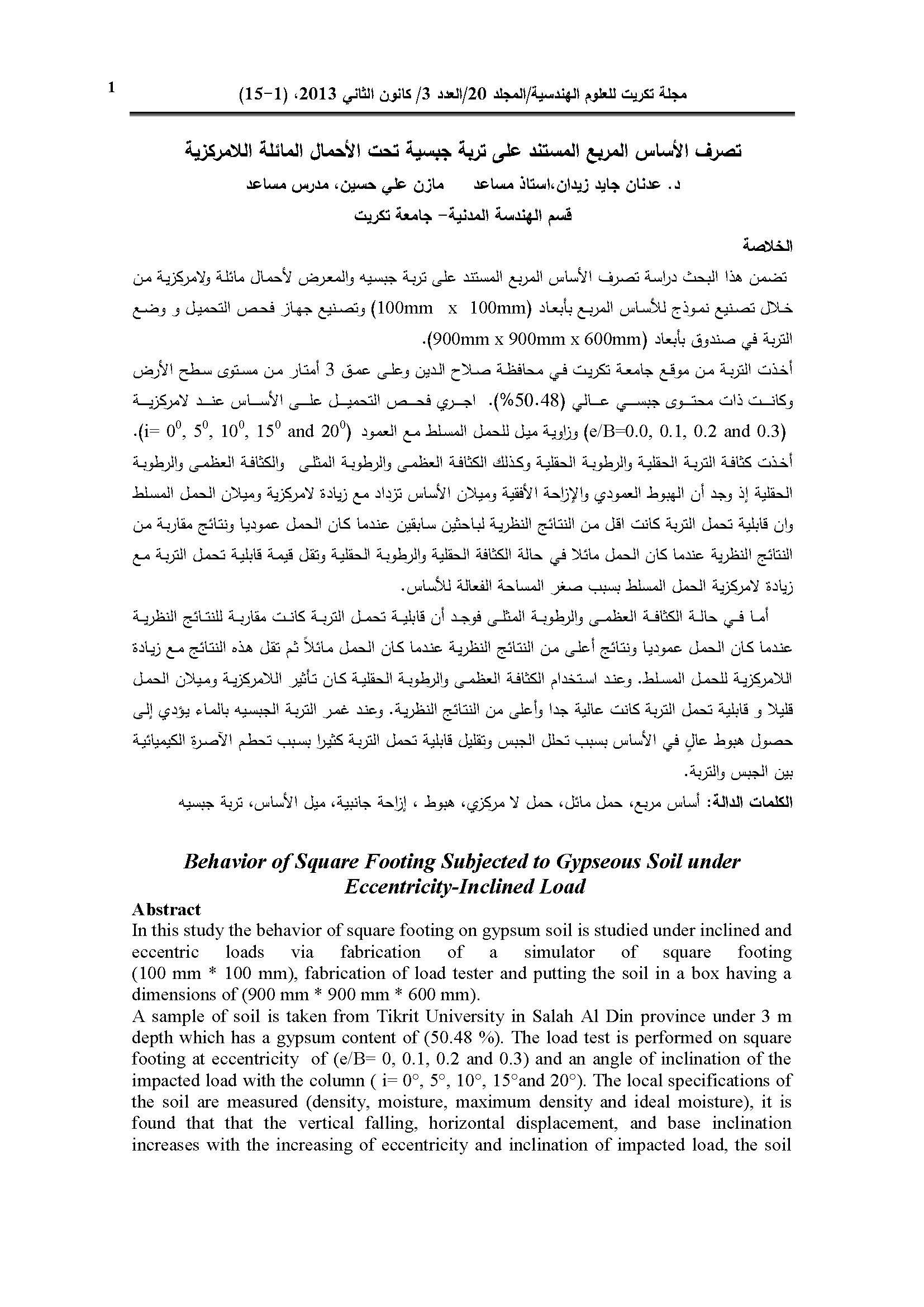Behavior of Square Footing Subjected to Gypseous Soil under Eccentricity-Inclined Load
Main Article Content
Abstract
In this study, the behavior of square footing on gypsum soil is studied under inclined and eccentric loads via fabrication of a simulator of square footing (100 mm * 100 mm), fabrication of load tester and putting the soil in a box having a dimension of (900 mm * 900 mm * 600 mm). A sample of soil is taken from Tikrit University in Salah Al-Din province under 3 m depth which has a gypsum content of (50.48 %). The load test is performed on square footing at eccentricity of (e/B= 0, 0.1, 0.2 and 0.3) and an angle of inclination of the impacted load with the column ( i= 0°, 5°, 10°, 15°and 20°). The local specifications of the soil are measured (density, moisture, maximum density and ideal moisture), it is found that that the vertical falling, horizontal displacement, and base inclination increases with the increasing of eccentricity and inclination of impacted load, the soil resistance is less than the theoretical results for previous researchers in vertical load whereas it is approaching the theoretical results in inclined load. It is also observed that soil resistance decreases with the increasing of eccentricity of impacted load at local density and humidity, whereas it approaches the theoretical results at maximum density, ideal moisture, and vertical load conditions and gives results higher than that of theoretical analysis in inclined load where it decreases with increasing the eccentricity of impacted load. It is found that a high settlement occur in footing when a water (unsaturated with gypsum salts) diffuses through the soil, then gypsum become soluble thereby the soil resistance decreases because of rupturing of chemical bond between gypsum and soil.
Metrics
Article Details

This work is licensed under a Creative Commons Attribution 4.0 International License.
THIS IS AN OPEN ACCESS ARTICLE UNDER THE CC BY LICENSE http://creativecommons.org/licenses/by/4.0/
Plaudit
References
Meyerhof , G.G (1953), “The Bearing Capacity of Foundation under Eccentric-incline Loads”, Proceedings Third International Conference on soil Mechanic and Foundation Engg., Zurich, Switzerland, Vol.1, pp.440-445.
Agrawal, R.K (1986), “Behavior of Shallow Subjected to Foundation Eccentric-Inclined Loads”, Ph.D. Thesis, University of Roorkee, (India).
Georgiadis, M. (1993), “Settlement and Rotation of Footing Embedded in Sand”, Soil and Foundation, Japan Society of SMFE, vol. 33 (1), pp.169-157. DOI: https://doi.org/10.3208/sandf1972.33.169
Zadroga, B, (1994), “Bearing Capacity of Shallow Foundation on Noncohesive soil”, Journal of Geotechnical. Engineering. ASCE, vol. (120)GT11, pp. 1991-2008. DOI: https://doi.org/10.1061/(ASCE)0733-9410(1994)120:11(1991)
Montrasio, L., and Nova, R. (1997), “Settlement of Shallow Foundation on Sand, Geometrical Effect”, Geotechniqu, vol. 47(1), pp. .49-60 DOI: https://doi.org/10.1680/geot.1997.47.1.49
Kumar, R. (2001), “Analysis of Eccentrically Obliquely Loaded Square Footing from constitutive Law’, M. E. Thesis, Dept. of Civil Engg., University of Roorkee, Roorkee (India).
Antonino M. and Ferlisis( 2008), ” Collapse of a Model Strip Footing on Dense Sand Under Vertical Eccentric Loads”, _ Springer Science+Business Media B.V. 2008
Al-Mufty, A.A. and Nashat, I.H. (2000), “Gypsum Content Determination in Gypseous Soils and Rocks”, 3rd International Jordanian Conference on Mining, pp. 500-506.
Georgiadis, M.and Butterfield, R. (1988),”Displacement of Footings on Sand under Eccentric and Incline loads”, Canadian Geot. Jnl., Vol. 25(2), pp. 199-212. DOI: https://doi.org/10.1139/t88-024
BS (1975), “Methods of Testing Soils for Civil Engineering Purposes” British Standards Institution.
Earth Manual, U.S. (1998), “Department of the Interior Bureau of Reclamatio”, 3rd Edition, 313p.





